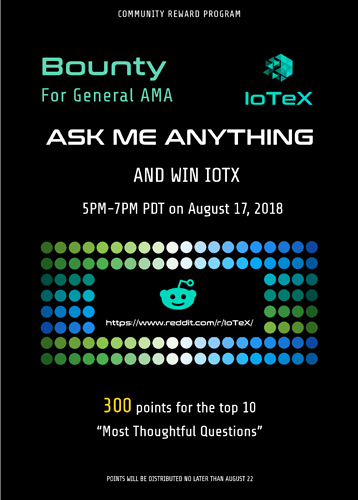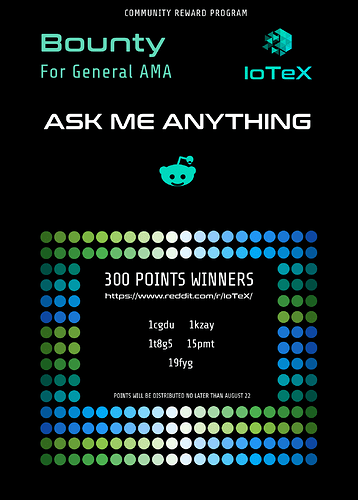Our general bi-weekly AMA on August 17 is now over! Thank you for engaging with us once again. We’ll see you on Reddit again in 2 weeks!
Congratulations to those who won bonus points from this AMA. If you weren’t able to participate in this AMA, no worries! Head on over to our subreddit linked below to get caught up with the conversation.
How to participate in the IoTeX AMA
- Subscribe to the IoTeX subreddit r/IoTeX
- Visit the pinned “IoTeX General AMA — August 17, 2018” post in the r/IoTeX subreddit on August 17, 2018 between 5PM-7PM PDT. We will also post a link in the official IoTeX Telegram group when the campaign starts. *Note: We will only accept questions submitted within the official AMA timeframe announced in this blog post.
- Ask us a question and include your unique IoTeX Hash ID (PM@IoTeXBountyBot and enter /hashid) — we will only give points for new questions (no duplicate questions)!
- We will answer the questions one by one in Reddit. If you have follow-up questions, please feel free to comment on our reply!
- We will also select the most thoughtful questions and give additional bonus points.
- We will transcribe the AMA and post the list of questions and answers to our Telegram group.
Point System
- “Most Thoughtful Questions” Bonus: 300 points (Up to 10 people, chosen by the IoTeX team)
*Note: Points will be distributed no later than August 22.
Rules
- Shoot us any questions you’ve got! Tech, team, our favorite desserts…anything at all.
- Profanity and spam messages are forbidden.
Most Thoughtful Questions
Congratulations to the 6 questions listed below which the IoTeX has handpicked to be the most thoughtful ones we received from our General AMA session on 8/17/18. Join us again on 8/31/18 for another AMA!
Q1: Every project at one point had to sacrifice something with significant importance to reach a goal. In that case, has the IoteX team or any individual part of the team sacrificed anything significant? If so, what is it and what was it to achieve?
Hi! Thanks for raising this good question! In our Testnet Alpha release, we mentioned that a common “tradeoff triangle” is one introduced by Vitalik, where he says a public blockchain can have two of the following three components: security, scalability, and decentralization of block production.
IoTeX is no different — we certainly make tradeoffs to cater to our ultimate use case of supporting the future of global IoT, where sensitive data (e.g., location of valuable goods) will be exchanged in a rapid manner across many types of devices and stakeholders. However, building a blockchain for IoT requires two other key tradeoff considerations that most public blockchains do not choose to / need to include in their upfront design: privacy and interoperability. Therefore, IoTeX’s upfront design decisions must not only find the appropriate balance of security, scalability, and decentralization but must also ensure that privacy and interoperability are prioritized. So we use three key innovations to tackle this challenge:
- Lightweight privacy-preserving techniques: full transaction privacy (i.e., encrypt sender, receiver, value) using lightweight cryptography — fun fact: Raullen (Co-founder) and Xinxin (Head of Cryptography) focused their Ph.D research at UWaterloo on lightweight cryptography!
- Roll-DPoS consensus mechanism: fast consensus and massive throughput with a more decentralized approach than normal DPoS (yellow paper coming on June 30)
- Blockchains-in-blockchain architecture: permissionless root chain which enables cross-chain communication between flexible, interoperable sub-chains of IoT device networks, with ability to add any number of sub-chains for high scalability
IoTeX’s long-term vision is to capture the full benefits of each of our key innovations while minimizing the negative impacts to other components — this is an ambitious goal, which requires fulfilling many complex technology and infrastructure requirements to make this a reality. Although we are still early on our innovation journey, we are excited to release Strive, which shows the initial blueprints of our upfront design decisions coming together: privacy via implementation of elliptic curve cryptography library, scalability and decentralization via full implementation of Roll-DPoS, and interoperability via account-based record keeping to manage sub-chains. By reaching this milestone, we have created a strong foundation for our future work and are one step closer to achieving our goal of connecting the physical world, block by block!
Q2: Does IoTeX plan to partner with a hardware wallet manufacturer such as a “Ledger” to allow cold storage for Mainnet coins? Will the design of the IoTeX blockchain allow for staking/voting while Mainnet coins are kept in cold storage?
Yes, that is definitely on our radar and will be executed after our Mainnet launch and token mapping is done. And to your second question — Yes, in the coming Testnet beta, IoTeX blockchain already has the voting function supported. In the meanwhile, we are already working staking function and the design of the token economy for BP (a.k.a. supernode) election.
Q3: Give 3 reasons on why we’re moving out of an ERC20 token.
- Moving out of ERC20 can better support an IoT context-rich blockchain (or a blockchain with IoT ecosystems running on top of it);
- It is fast and efficient since the current network is not tailor-fit for IoT.
- It can better support our privacy-preserving transaction in the future.
Q4: As you see the IoT-market in the near future, how long of a time will it take IoT technology for mass adoption?
To be honest, it depends on how fast the technology will reach a new level. In general, IoT is still far from reaching mass adoption and lacks “killer applications” that would draw new users to the ecosystem due to issues such as low scalability, high operating cost, privacy concerns and lack of functional values. Therefore, what we do is to tackle these problems by introducing token economy into IoT spaces as we strongly believe that crypto incentives, as well as the community effort, are the two key forces to propel innovations in IoT space.
Similar to the Internet, blockchain is providing a completely new way to think about transacting with others in a decentralized and trustless fashion. We don’t think about blockchain as replacing any legacy technologies (e.g., cloud); rather, it provides opportunities to create brand new products and services. So it requires a lot of time and effort from the tech development perspective. If you are our early supporter, you will know that we are building the whole infrastructure from scratch. We are still in the early days of blockchain, which makes the mass adoption very difficult to start and implement. It will take a long time to dig dive into the technology and deliver something real and meaningful. There are a lot of challenges but fortunately, we have seen some projects and leading-industry experts are working hard on it. We will also work together to fast the pace of achieving our vision of “connecting the physical world block by block”.
Q5: As the IoTeX native token will be used for transactions and many other functions and with the amazing tech that is being developed rapidly on blockchain technology nowadays, many people have concerns with the volatility of them and that the major swings in markets may be a very big wall standing between the tech and mass adoption. First of all, is IoTeX thinking of this and how would the team propose to overcome the issue if, for instance, the price of transaction on the IoTeX blockchain one day may cost the equivalent amount of tokens to 1 USD cent and the next day all of the sudden the price of the token in the markets would rise by 30%? If huge entities would be involved in IoTeX blockchain that would be catastrophic for them and I’m sure they will think of that. How do you plan to address the issue?
Thanks for raising this great questions! This is a crucial part that we have discussed and planned for a long time. Currently, our development is still in the Testnet phase, so the exact transaction cost structure and pricing will be determined around Mainnet launch time. Transaction cost structure and pricing is a vital part of the token economy for a project to be successful, and we hope to create a well-balanced structure for both miners and users in order to stay competitive with other mainstream projects in the market. Additionally, we will test run several pricing models in our Testnet and Mainnet Preview development cycles.
Q6: Apart from partnerships with Weeve, LianAn, SmartHab, Lineable and Celer (on which you have detailed explanations on cooperation), there is also a partnership with emerging CertiK that would be great to expand on.
a) How significant of a role will smart contracts play in IoTeX blockchain in the future?
b) Why do you think you can trust CertiK engineers’ skill sets to validate smart contracts for your chain?
c) Will you fully rely on CertiK to test for bug-free and resistance of hackers smart contracts or will you try to make parallel partners test the contracts from various angles?
A smart contract is a key component to enable automatic exchange of data and value, it plays an important role in IoTeX blockchain, e.g., management of the subchains using smart contracts. Formal verification is a methodology to check and validate the logical correctness of intended algorithms/systems using formal methods based on mathematics. We will have collaborated research with CertiK in the field of formal verification (rather than have their engineers audit smart contracts on IoTeX blockchains). While formal verification provides a powerful tool to validate the smart contract, in theory, it’s almost impossible to claim a piece of software/code being absolutely bug-free, so we welcome inspection and validation from various angles, especially from the community to safeguard smart contract security and resist hacker attack.

